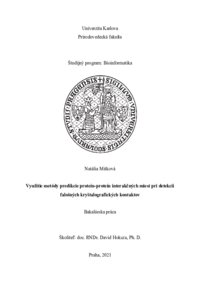Využití metody predikce protein-protein interakčních míst pro detekci falešných krystalografických kontaktů
Identification of crystal packing contacts using a method for detection of protein-protein interaction sites
bakalářská práce (OBHÁJENO)

Zobrazit/
Trvalý odkaz
http://hdl.handle.net/20.500.11956/171799Identifikátory
SIS: 221749
Kolekce
- Kvalifikační práce [21483]
Autor
Vedoucí práce
Oponent práce
Jakubec, Dávid
Fakulta / součást
Přírodovědecká fakulta
Obor
Bioinformatika
Katedra / ústav / klinika
Katedra buněčné biologie
Datum obhajoby
9. 2. 2022
Nakladatel
Univerzita Karlova, Přírodovědecká fakultaJazyk
Čeština
Známka
Dobře
Klíčová slova (česky)
bioinformatika, proteinová struktura, protein-protein interakceKlíčová slova (anglicky)
bioinformatics, protein structure, protein-protein interactionsJedným zo zásadných problémov pri získavaní kvartérnej štruktúry proteínov je rozlíšenie biologických kontaktov od falošných rozhraní, ktoré sú artefaktom kryštalizácie proteínu predchádzajúcej samotnému určeniu terciárnej a kvartérnej štruktúry. Získanie znalostí o interakcii proteínov v 3D priestore je kľúčové pre pochopenie ich funkcií a ponúka sa možnosť tieto znalosti využiť pri analýze vplyvu inhibítorov, návrhu liekov, imunoterapii alebo návrhu nových proteínov. Taktiež je táto informácia nevyhnutnou požiadavkou pri aplikácii in silico prístupov. Bakalárska práca je rozdelená na dve časti. V prvej časti sa nachádza rešerš existujúcich metód riešiacich problém detekcie kryštalografických kontaktov spoločne s príslušnými datasetmi pre objektívne vyhodnotenie schopností riešiť túto problematiku. Druhá praktická časť je zameraná na porovnanie vyhodnotenia schopností už skôr vyvinutej metódy na rozlíšenie proteín-proteín interakčných miest INSPiRE a klasifikátora EPPIC. Kľúčové slová: bioinformatika, kryštalografický kontakt, kryštalizácia, proteínová štruktúra, proteín-proteín interakcia
One of the fundamental issues when obtaining the protein quaternary structures is to be able distinguish biological interfaces from crystal packing contacts. The existence of these false contacts is the consequence of the crystallographic method which is used for obtaining the tertiary and quaternary structure. Gaining knowledge of how proteins interact in 3D space is key to understanding their functions and offers the opportunity to apply the knowledge to inhibitor impact analysis, drug design, immunotherapy, or de novo protein design. Furthermore, this knowledge is an essential requirement when applying in silico approaches. The bachelor thesis is divided into two parts. The first part contains literature retrieval of existing methods addressing the problem of crystallographic contact detection together with relevant datasets for an objective evaluation. The second practical part is focused on the comparison of evaluations of the previously developed method for the protein-protein interface prediction, INSPiRE, and the EPPIC classifier. Key words: bioinformatics, crystal packing contact, crystallography, protein structure, protein- protein interactions
Citace dokumentu
Metadata
Zobrazit celý záznamSouvisející záznamy
Zobrazují se záznamy příbuzné na základě názvu, autora a předmětu.
-
Applications of graph theory in protein function prediction
Výsledek obhajoby: OBHÁJENOKalábová, Nikola (Univerzita Karlova, Přírodovědecká fakulta, 2021)Datum obhajoby: 8. 6. 2021Rapidní vývoj celogenomových sekvenačních metod a jejich snižující se cena za- příčinila existenci velkého množství osekvenovaných genomů. Vývoj spolehlivých in-silico metod pro anotaci rychle rostoucího počtu osekvenovaných ... -
Funkční studie potenciální nukleotidázy kódované genem spr1057 Streptococcus pneumoniae, homologa proteinu YjjG E. coli
Výsledek obhajoby: OBHÁJENOVacková, Zuzana (Univerzita Karlova, Přírodovědecká fakulta, 2010)Datum obhajoby: 31. 5. 2010ČESKÝ ABSTRAKT Funkční studie potenciální nukleotidasy kódované genem spr1057 v Streptococcus pneumoniae, homologa proteinu YjjG Escherichia coli. Bakteriální buňky jsou neustále vystavovány nespočetným toxickým látkám, ... -
Role of the ubiquitin-like protein, Hub1, in the pre-mRNA splicing regulation
Výsledek obhajoby: OBHÁJENOHubáčková, Tereza (Univerzita Karlova, Přírodovědecká fakulta, 2018)Datum obhajoby: 4. 6. 2018Splicing is a key step of eukaryotic gene expression and as well as other steps of this vital process, splicing has to be tightly regulated. Hub1 protein is a ubiquitin-like protein which noncovalently interacts with ...
